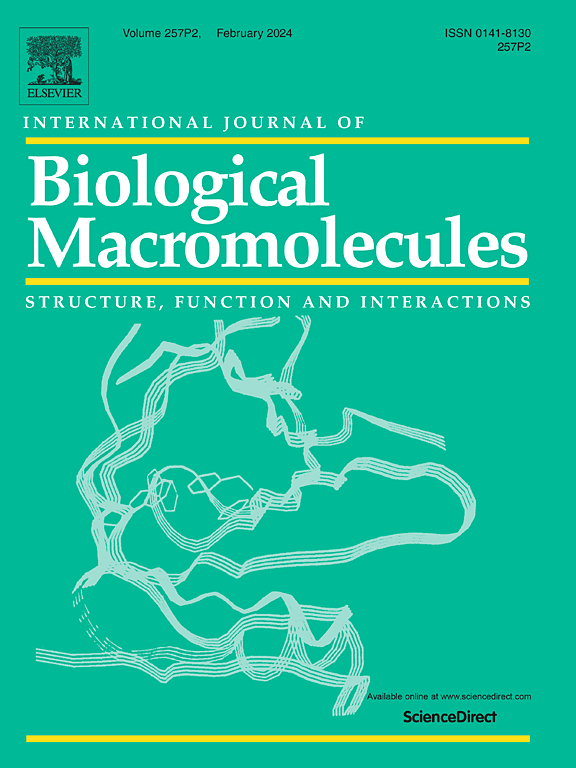Enhanced soluble expression and improved catalytic efficiency of heparinase II by fusion of GST tag to the backside of the active pocket
IF 8.5
1区 化学
Q1 BIOCHEMISTRY & MOLECULAR BIOLOGY
International Journal of Biological Macromolecules
Pub Date : 2025-09-24
DOI:10.1016/j.ijbiomac.2025.147877
引用次数: 0
Abstract
Although heparinase II has been widely used in the structural analysis of heparin and HS, it suffers from low activity and inefficient expression and purification. In this study, heparinase II from Mariniphaga anaerophila (MaHepII) was cloned, and the GST tag was fused to the backside of the enzyme's active pocket. The fusion protein GST-MaHepII was efficiently expressed in the recombinant Escherichia coli BL21. Afterward, Ni-NTA affinity chromatography was used to purify GST-MaHepII, with an enzymatic activity recovery yield of 70.3 % and a specific activity of 7.5 U mg−1 toward heparin. When HS was used as the substrate, the enzyme exhibited a specific activity of 11.1 U mg−1. Additionally, the influence of the GST tag on the enzymatic properties of MaHepII was evaluated. After removal of the GST tag by proteolytic cleavage, MaHepII was purified by GSH affinity chromatography. Characterization of the enzymatic properties indicated that the GST tag improved the catalytic efficiency of MaHepII by 3.1-fold toward heparin and 1.4-fold toward HS. Molecular docking revealed that the GST tag fusion might increase the flexibility of the protein structure and alter the size or shape of the substrate channel. These changes facilitate substrate access to the active site and enhance the catalytic efficiency of MaHepII.
通过将GST标签融合到活性口袋的背面,增强了肝素酶II的可溶性表达,提高了催化效率
虽然肝素酶II已广泛应用于肝素和HS的结构分析,但其存在活性低、表达和纯化效率低的问题。本研究克隆了Mariniphaga anaerophila的肝素酶II (MaHepII),并将GST标签融合到酶活性袋的背面。融合蛋白GST-MaHepII在重组大肠杆菌BL21中高效表达。随后,采用Ni-NTA亲和层析纯化GST-MaHepII,酶活性回收率为70.3%,对肝素的比活性为7.5 U mg−1。以HS为底物时,酶的比活性为11.1 U mg−1。此外,还评估了GST标签对MaHepII酶学性质的影响。通过蛋白水解裂解去除GST标签后,用GSH亲和层析纯化MaHepII。酶学性质表征表明,GST标签将MaHepII对肝素的催化效率提高了3.1倍,对HS的催化效率提高了1.4倍。分子对接表明,GST标签融合可能增加蛋白质结构的灵活性,改变底物通道的大小或形状。这些变化有利于底物进入活性位点,提高了MaHepII的催化效率。
本文章由计算机程序翻译,如有差异,请以英文原文为准。
求助全文
约1分钟内获得全文
求助全文
来源期刊
CiteScore
13.70
自引率
9.80%
发文量
2728
审稿时长
64 days
期刊介绍:
The International Journal of Biological Macromolecules is a well-established international journal dedicated to research on the chemical and biological aspects of natural macromolecules. Focusing on proteins, macromolecular carbohydrates, glycoproteins, proteoglycans, lignins, biological poly-acids, and nucleic acids, the journal presents the latest findings in molecular structure, properties, biological activities, interactions, modifications, and functional properties. Papers must offer new and novel insights, encompassing related model systems, structural conformational studies, theoretical developments, and analytical techniques. Each paper is required to primarily focus on at least one named biological macromolecule, reflected in the title, abstract, and text.

 求助内容:
求助内容: 应助结果提醒方式:
应助结果提醒方式:


